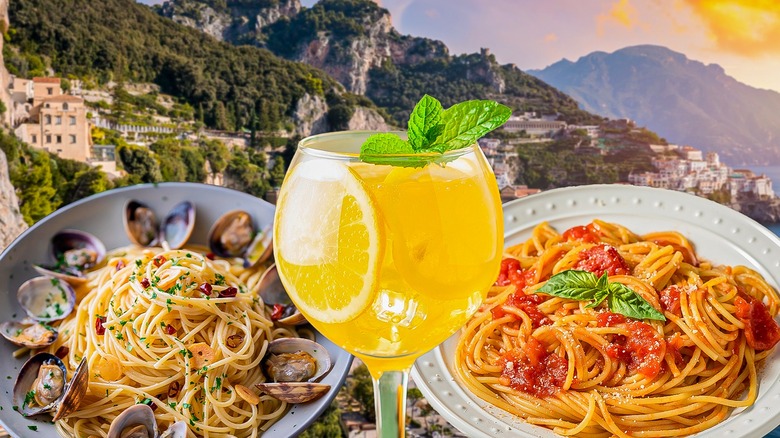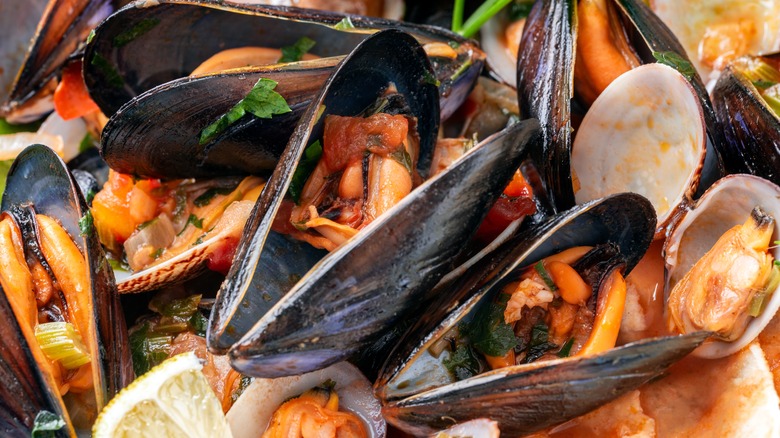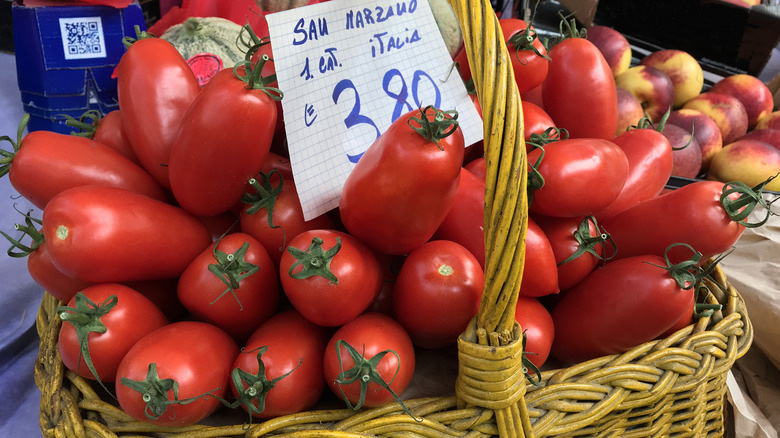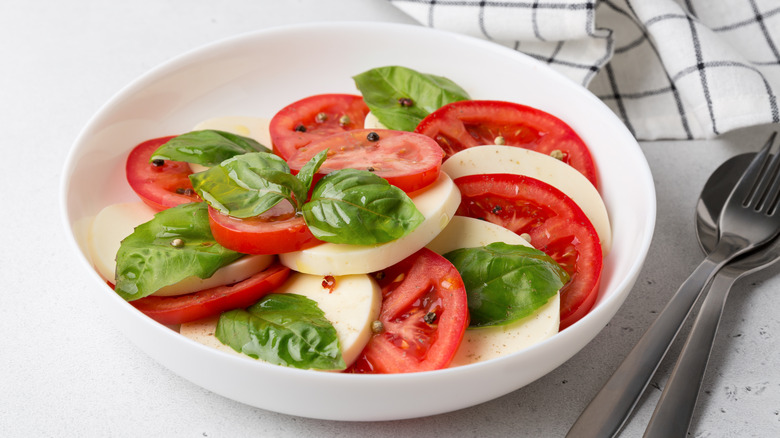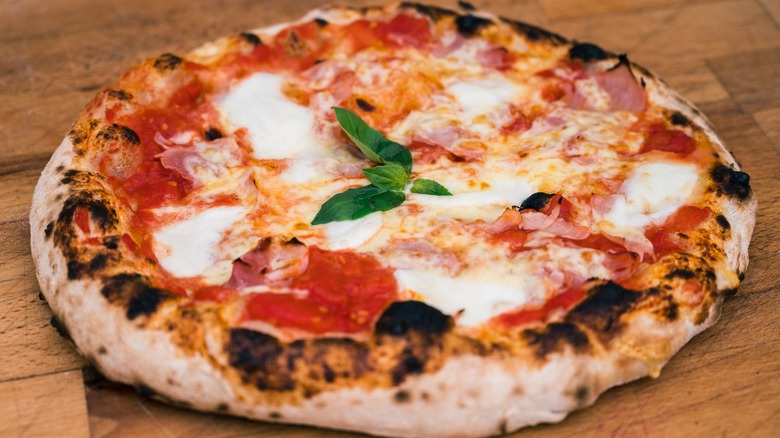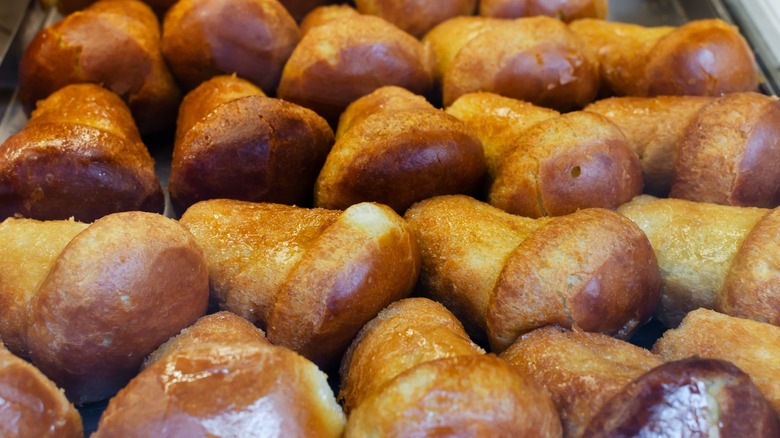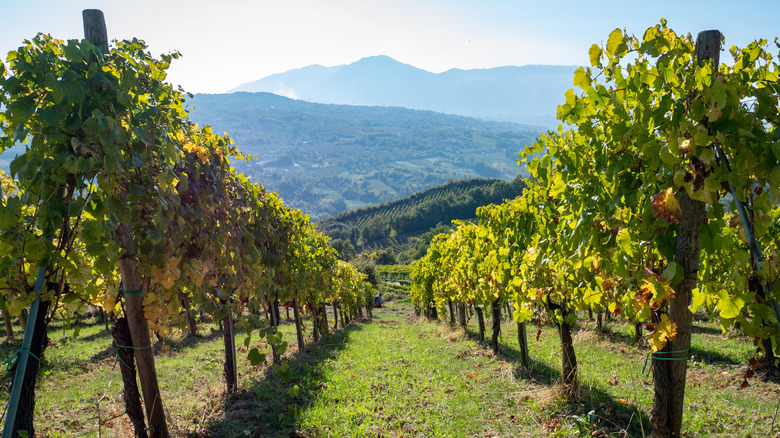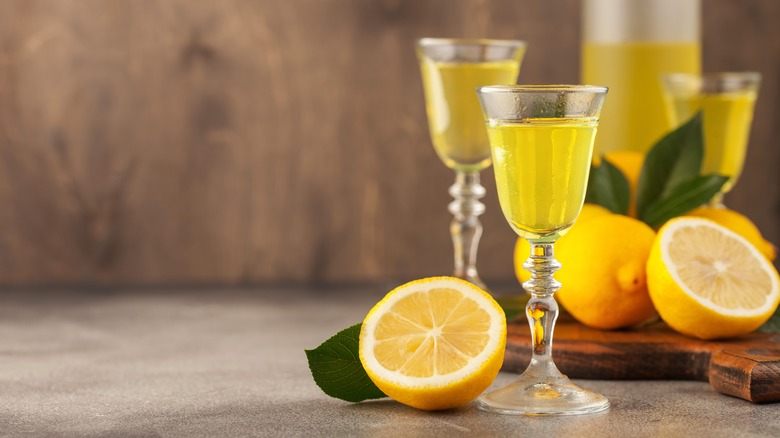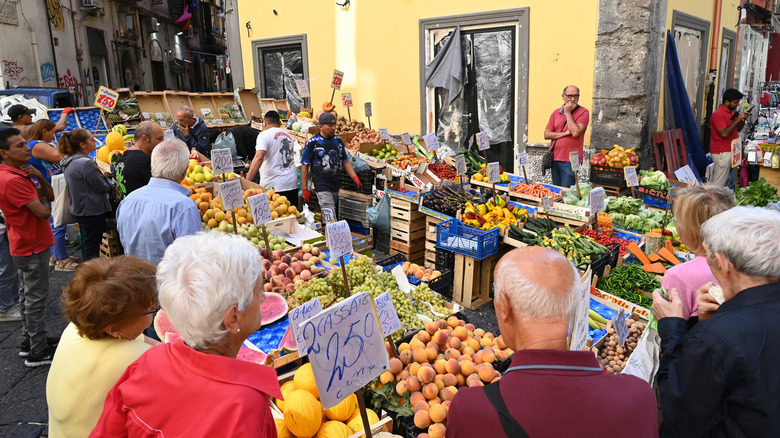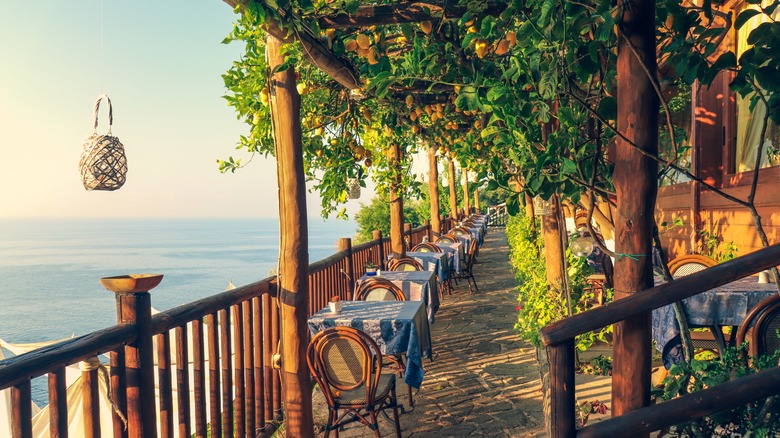Campania: The Italian Countryside That Foodies Should Know About
Italy's landscape is rich with variety, which translates to an abundance of diversity in the culinary sphere. While certain Italian dishes are ubiquitous around the world, there's still a strong sense of regional cuisines. And you may know that you love Italian food, but do you know which region specializes in your favorite dishes? As it turns out, chances are the answer to that question is often Campania.
This southern Italian region is the source of some of the country's most popular culinary exports, including pizza Napoletana, Caprese salad, and even eggplant Parmesan (depending on the account). For an area that's given the world such delicious foods, many people know too little about Campania, apart from iconic sites like Pompeii, Mount Vesuvius, and the Amalfi Coast.
We spoke to Campanian chefs and culinary experts to understand the ins and outs of this beautiful area. Rosario Procino grew up in Naples and now co-owns Ribalta and Amo Seafood in NYC with chef Pasquale Cozzolino, another Campania native. Additionally, we spoke with Cristian Pappalardo from the town of Maiori on the Amalfi Coast, the chef at Casa Mandina, which he co-owns with his brother Alfonso. From climate and agriculture to local delicacies, they shared the scoop. Read on to learn all about Campania — and perhaps inspire your next holiday.
The volcanic terrain promotes mineral-rich soils for agriculture
Volcanoes are dazzling geological formations with explosive features, and they lend unique characteristics to their surrounding environments. Of course, these are detrimental in the face of a large eruption, but alterations to the soil and landscape can also result in one-of-a-kind qualities. Mount Vesuvius is a major landmark in Campania, attracting tourism, awe, and constantly evolving terrain.
Very much still active, the volcano has the capacity to dramatically change the composition of its surrounding environment with every eruption. Both the physical scenery and the minerals and compounds in the soil are affected. Growing up in the region, Cristian Pappalardo is familiar with these effects and comments that the magnitude of Vesuvius "provides nourishment and richness to our lands." This is both positive for food production and viticulture, as the area is home to many vineyards, too.
Typically, magnesium and potassium are present in high levels around volcanoes, which in turn results in very fertile soils. Half of the battle when farming is optimizing the composition of the soil to find the right balance, and an ashy soil high in nutrients is a huge asset that can promote crop growth for several years after eruptions occur. Additionally, regulating water is another key component of farming and a tricky one to master in a hot area like Campania. Volcanic soil tends to absorb moisture well, providing yet another agricultural benefit as far as irrigation.
The Mediterranean climate offers plenty of sunlight
It's no secret that a Mediterranean climate is enviable for numerous reasons, and Campania experiences it fully. Rosario Procino describes, "Napoli, known as the 'Land of the Sun,' with its hot summer and mild winter, boasts a Mediterranean climate perfect for growing an array of ingredients." While Campania extends beyond the city of Naples, it is by far the biggest hub, and its proximity to water tempers the summer heat and temperature dips in the winter.
The inland terrain is generally rugged and mountainous, with more of a continental climate that is not as favorable to farming. Consequently, a lot of the regional agriculture is focused close to Salerno and Naples, taking advantage of the sunny climate and fertile soils from Vesuvius. These environmental characteristics result in excellent crops, and as Procino notes, "Campania is renowned for its exceptional ingredients, reflecting its Mediterranean climate, fertile soil, and coastal location."
The coastal location guarantees an influx of seafood
Apart from the fertile soil and abundant sunshine, Campania boasts a couple of hundred miles of coastline bordering the Tyrrhenian Sea. As such, there's a booming fishing industry in the region that spans generations — back to the time of the Romans! Since then, the domain has been a steady source of employment for many Campanian families, strengthening its importance in the local culture. About the town of Maiori on the Amalfi Coast, Cristian Pappalardo shares, "I was born in this area, which holds many culinary traditions passed down from families of farmers and fishermen."
Shellfish is the main catch (especially mussels), though some types of fish, like cod, seabass, grouper, bluefin tuna, and sardines, are also harvested in the region. Anchovies are another major catch, either salted for preservation or sold fresh. Squid, shrimp, prawns, octopus, and clams are also commonly harvested and feature in numerous local dishes. Rosario Procino's only request: "Please, no parmigiano on seafood."
The area's bounty proves that less is more
Some cuisines focus on elaborate blends of spices, seasonings, and sauces to enhance ingredients and transform them into delicious meals. In Campania, the approach is quite the opposite, with the ingredients sparsely modified before being served. As Rosario Procino points out, the optimal growing conditions are responsible for this minimal approach. "This allows Campanian cuisine to focus on simplicity, showcasing the flavors of its ingredients. When ingredients are that good, there is no need to cover them up in butter, cream, and heavy sauces."
Instead, the regional cuisine features the ingredients for what they are, without any touch-ups. Procino mentions ingredients that are especially prized in Campania (and several worldwide), listing favorites including fresh produce like San Marzano and piennolo tomatoes, Sorrento lemons, and broccoli rabe, as well as various types of cheese like mozzarella di bufala, provolone, and caciocavallo. Of course, fresh seafood needs very little to enjoy, and there's plenty of it in the local waters. When enjoyed fresh with nothing more than a drizzle of olive oil and a sprinkle of salt (if that), it's easy to agree with Procino when he comments, "Simplicity and quality of ingredients are the key words when talking of food in Campania."
Recipes often stick to simple formulations
Since Campanian ingredients are already brimming with nuanced flavors, it makes sense that the regional cuisine features many simple recipes. Instead of long preparations that involve stewing and braising, many dishes are served fresh or cooked briefly in a hot pan. Seafood is commonly served raw, grilled, fried, roasted, or poached, along with fresh Sorrento lemons to add a kick of acidity. Case in point: Fritto misto di mare, a traditional street food in Naples, consisting of assorted seafood fried with a light batter.
San Marzano tomatoes are revered for their subtle sweetness and depth of flavor and are featured fresh in dishes like Caprese salad. Of course, they are also a key component of the local tomato sauce, in which they're stewed for hours to highlight their sweet qualities. As for the wide array of cheeses, the region's terroir infuses a unique taste into these products, which are highly dependent on the environment. Cristian Pappalardo describes mozzarella as "the queen of cheeses — that changes in shape and flavor depending on its origin."
Some of the most iconic Italian dishes come from Campania
"The list of staple dishes from Napoli is incredibly long, and surprisingly, many of the most iconic Italian dishes abroad originate from this region," Rosario Procino remarks. Indeed, if your introduction to Italian food came in the format of a Margherita pizza, then your familiarity with Campanian cuisine started there. The world-famous specialty comes from the Southern region and features two of the area's prime ingredients: San Marzano tomatoes and mozzarella di bufala. With its thin charred crust and simple ingredients, Neapolitan pizza is regulated to guarantee its quality and authenticity. On the lighter side, a Caprese salad is a favorite on antipasti menus, featuring mozzarella, tomatoes, and fresh basil in a different light.
A few regions stake a claim on eggplant parmesan, including Campania, and it's fair to say the excellent local produce and dairy result in a delicious version. As for pasta dishes, Campania is home to classics like spaghetti alle vongole, which displays the coast's fresh clams front and center. Puttanesca is another local pasta delicacy, showcasing a flavor-packed sauce made with tomatoes, anchovies, olives, capers, and chili flakes. On the meat front, Procino raves about "the iconic Neapolitan ragù, which is typically cooked for a minimum of 8-12 hours." Unlike a bolognese ragù, the sauce is stewed with whole cuts of meat which are then served as a second course following the pasta.
Sweet treats aren't left out
If all this talk of tomatoes, mozzarella, and seafood has you thinking Campania isn't the place to satisfy your sweet tooth, think again. The region is home to several desserts, including specialty pastries and cakes. Certain recipes follow religious holidays, with delicacies prepared in the weeks leading up to Easter and Christmas.
Among the popular treats, you'll find sfogliatelle, a flaky multi-layered treat stuffed with ricotta and semolina, that's commonly served with coffee for breakfast. Meanwhile, babà is a portion-sized pastry that's more of a spongy cake shaped like a cone and typically soaked in rum or citrus syrup. Rosario Procino is fond of these and also mentions pastiera, a festive cake served at Easter, made with wheat flour, ricotta, eggs, and orange water.
Other cakes like migliaccio, made with corn or millet flour, ricotta, eggs, and candied orange, or raffiolo, a sponge cake stuffed with apricot jam and dusted with icing sugar, are popular in Campania. Cookies like roccocò, a dry biscuit filled with almonds, dry fruit, and spices are typical during Advent and Christmas. Of course, lemons feature in the sweet treats too, such as delizia al limone, which consists of a layer of lemon cream sandwiched between two small sponge cakes and coated in a lemon glaze.
Local wines made from indigenous grapes offer the perfect pairing
It wouldn't be an Italian meal without wine on the table, and unsurprisingly, Campania excels in this domain as well. "Campania's unique terroir, characterized by volcanic soils and a Mediterranean climate, fosters an impressive array of indigenous grape varieties," Rosario Procino explains. Wines made with vines growing in volcanic soils tend to have noteworthy qualities, such as concentrated flavors and balanced acidity. With vineyards planted on the slopes of Vesuvius, Campanian wine has something special going on.
Italy is home to hundreds of native varieties, and what's grown elsewhere in the country isn't the same as what you'll find here. "Our region boasts some of Italy's most acclaimed wines, including aglianico in its various expressions, and exceptional white wines such as Greco di Tufo, falanghina, and fiano," Procino notes. Cristian Pappalardo agrees about the unique nature of the region's viticultural tradition, calling out fiano as his favorite variety. Even within the region of Campania, he adds, "These wines also take on a distinct 'flavor' depending on where they are produced."
According to Pappalardo, "In recent years, more and more wineries have emerged, honoring and preserving the true authenticity of these places." Of course, winemaking is by no means new to the region. It is one of the oldest viticultural areas of the country, with a tradition that goes back as far back as the 12th century.
Italy's lemon liqueur comes from Campania
If you're into imbibing boozier drinks, Campania is the home of limoncello, Italy's iconic lemon liqueur. Although the specifics are often disputed, it likely originates from either Sorrento, the Amalfi coast, or the island of Capri. With an abundance of lemons in the area, it wasn't such a stretch to transform the tangy fruit into an alcoholic beverage. Originally, limoncello was produced and served chilled as a digestif, but it is now enjoyed on different occasions and incorporated into cocktails and mixed drinks.
The classic artisanal way to make the liqueur is by steeping lemon peels in pure alcohol for a minimum of two weeks, then adjusting the flavor with sugar and water. Naturally, this isn't the only method to produce it, and consequently, there's a wide range of limoncello quality levels. For a subtler taste and lower alcohol content, cream limoncello combines the liqueur with milk and cream for a softer and richer result.
Plenty of food tours highlight the region's offerings
The best way to discover a particular cuisine is by visiting the region and tasting it for yourself. Of course, you could try your hand at cooking specialties at home, but as Rosario Procino notes, "The biggest challenge may be in sourcing the right ingredients." Cristian Pappalardo suggests, "I encourage you to seek out and buy products from Campania online," though he adds, "The only way to truly know all these dishes is to experience our territory."
Once you manage to make the trip to the Southern Italian region, you'll want to dive in for the full experience. Apart from your daily meals, participating in a food tour is a great way to discover more delicacies. There are plenty of tours on offer in Campania, especially in Naples, ranging from a couple of hours to several days long. Tours often include visits to meet farmers and artisanal producers, providing a holistic view of the culinary landscape. Meanwhile, cooking classes are another great way to explore Campanian food and learn a few skills to recreate the dishes at home.
Dining options abound from casual to Michelin
Eating street food in Naples can be a peak experience for some travelers, whereas others might feel the same way about a meal at a Michelin-starred restaurant. In Campania, you can experience both extremes. Naples is home to plenty of on-the-go bites, from cuoppo, a paper cup filled with assorted fried food to frittatina di pasta, a fried mass of macaroni, bechamel sauce, ham, and cheese. There are also folded pizza slices, stuffed sandwiches, and fried squash blossoms among the many street eats.
At the other end of the spectrum, Campania has 49 restaurants with either one, two, or three Michelin stars, an admirable achievement for any region. For anyone passionate about mozzarella di bufala, a visit to Le Colonne Marziale in the town of Caserta is a must. Boasting one Michelin star, the family-run restaurant features dazzling cheesy creations by chef Rosanna Marziale, also known as The Queen of Mozzarella. Meanwhile, if you're after a romantic meal, pretty much any terrace on the Amalfi coast with the backdrop of the Tyrrhenian Sea will do the trick. It won't just be a pretty view either; there are countless establishments boasting both a great atmosphere and delicious food.
